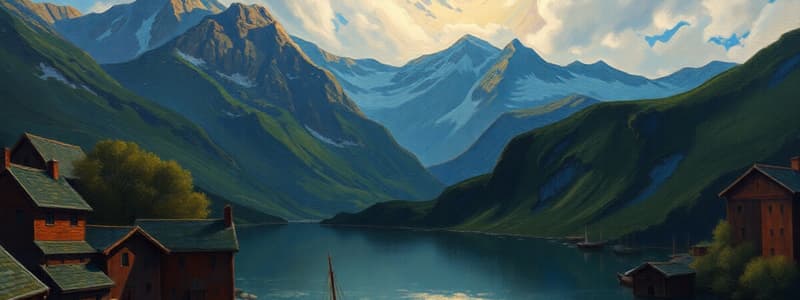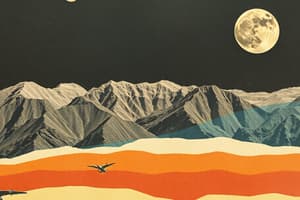Podcast
Questions and Answers
What is the outermost layer of the Earth called?
What is the outermost layer of the Earth called?
- Crust (correct)
- Core
- Lithosphere
- Mantle
Transform boundaries are a type of tectonic plate boundary.
Transform boundaries are a type of tectonic plate boundary.
True (A)
What causes the seasons on Earth?
What causes the seasons on Earth?
The Earth's tilted axis
The ______ layer of the Earth is liquid.
The ______ layer of the Earth is liquid.
What percentage of the Earth's surface is covered by water?
What percentage of the Earth's surface is covered by water?
Which of the following is NOT a layer of the atmosphere?
Which of the following is NOT a layer of the atmosphere?
Match the following terms related to the water cycle with their correct descriptions:
Match the following terms related to the water cycle with their correct descriptions:
Moon phases directly affect climate.
Moon phases directly affect climate.
What role do decomposers play in the carbon cycle?
What role do decomposers play in the carbon cycle?
Why are coral reefs important to the ocean ecosystem?
Why are coral reefs important to the ocean ecosystem?
What would happen if gravity stopped working?
What would happen if gravity stopped working?
Tectonic plates can push against each other, forcing the Earth's crust upward.
Tectonic plates can push against each other, forcing the Earth's crust upward.
What are convection currents in the mantle?
What are convection currents in the mantle?
The __________ influences the amount of sunlight different parts of the planet receive.
The __________ influences the amount of sunlight different parts of the planet receive.
Match the following phenomena with their causes:
Match the following phenomena with their causes:
Which of the following is NOT a reason the poles experience long periods of darkness or daylight?
Which of the following is NOT a reason the poles experience long periods of darkness or daylight?
The lithosphere interacts with the asthenosphere, impacting plate tectonics.
The lithosphere interacts with the asthenosphere, impacting plate tectonics.
Why do we see different shapes of the Moon from Earth?
Why do we see different shapes of the Moon from Earth?
The __________ describes the relationship between Earth's distance from the Sun and its atmospheric conditions.
The __________ describes the relationship between Earth's distance from the Sun and its atmospheric conditions.
List two potential impacts of rising sea levels on coastal ecosystems.
List two potential impacts of rising sea levels on coastal ecosystems.
Flashcards
What is the Earth's crust?
What is the Earth's crust?
The outermost layer of the Earth, a thin, brittle layer composed of mostly rock.
What are tectonic plates?
What are tectonic plates?
The process by which the Earth's tectonic plates move and interact.
What causes the Earth's seasons?
What causes the Earth's seasons?
The tilting of the Earth's axis at 23.5 degrees, causing different parts of the Earth to receive varying amounts of sunlight throughout the year.
What is the Earth's outer core?
What is the Earth's outer core?
Signup and view all the flashcards
What are ocean currents?
What are ocean currents?
Signup and view all the flashcards
What is the atmosphere?
What is the atmosphere?
Signup and view all the flashcards
What is the Earth's magnetic field?
What is the Earth's magnetic field?
Signup and view all the flashcards
What is climate?
What is climate?
Signup and view all the flashcards
What are renewable resources?
What are renewable resources?
Signup and view all the flashcards
What are seismic waves?
What are seismic waves?
Signup and view all the flashcards
Plate Tectonics
Plate Tectonics
Signup and view all the flashcards
Moon's Phases
Moon's Phases
Signup and view all the flashcards
Earth's Core
Earth's Core
Signup and view all the flashcards
Lithosphere and Asthenosphere
Lithosphere and Asthenosphere
Signup and view all the flashcards
Earth's Shape
Earth's Shape
Signup and view all the flashcards
Day and Night
Day and Night
Signup and view all the flashcards
Seasons
Seasons
Signup and view all the flashcards
The Equator
The Equator
Signup and view all the flashcards
Polar Days and Nights
Polar Days and Nights
Signup and view all the flashcards
Tides
Tides
Signup and view all the flashcards
Study Notes
Planet Earth Exam - Unit 3
- Outermost layer of Earth: Crust
- Types of tectonic plate boundaries: Convergent, Divergent, Transform
- Causes of seasons on Earth: Earth's tilted axis
- Liquid layer within Earth: Outer core
- Percentage of Earth's surface covered by water: Approximately 70%
- Atmosphere Layers (not a layer): Lithosphere
- Main cause of ocean currents: Wind patterns
- Earth's magnetic field cause: Movement of molten iron in the outer core
- Factors that do not affect climate: Moon phases
- Non-renewable resource: Coal
- How Earthquakes help understand Earth's interior: Generating seismic waves passing through Earth
- Role of decomposers in the carbon cycle: Break down dead organisms, releasing carbon back into the environment
- Climate change effects on water cycle: Increased frequency and intensity of precipitation in some regions
- Importance of coral reefs: Providing habitat for many species, protecting coastlines
- Earth's tilt causes (regarding seasons): Uneven distribution of sunlight
- Tectonic plates' effect on mountain formation: Pushing Earth's crust upward from collisions
- Convection currents in the mantle impact on plate tectonics: Contributing to plate movement; crucial for understanding earthquakes and volcanoes.
- Moon phases: Moon's orbit around Earth, resulting in varying illumination
- Day and night cause: Earth's rotation
- Difference between inner and outer core: Physical state (inner is solid, outer is liquid), impact on magnetic field
- Lithosphere and asthenosphere interaction: Crucial for plate tectonics, as the lithosphere interacts with the softer, flowing asthenosphere.
- Earth's shape and gravity: Not a perfect sphere; shape affects gravity variation at different locations
- Earth's rotation's impact on the day and night cycle: The rotation of the Earth causes day and night.
- Significance of the equator's effect on climate zones: The equator receives the most direct sunlight, influencing climate patterns.
- Polar Regions' extended periods of darkness/light: Earth's tilt and revolution cause varying lengths of daylight.
- Moon's impact on tides: The Moon's gravitational pull causes tides; two high tides and two low tides daily due to the alignment of the Earth, Moon, and Sun.
Essay Questions
- Relationship between Earth's rotation, tilt and revolution, and their effects: These movements affect seasons, day/night cycles, and the phases of the Moon. These processes are important for sustaining life on Earth
- Impact of climate change on coastal ecosystems: Rising sea levels and increased ocean temperatures will impact the plants and animals.
- Possible solutions for preserving coastal ecosystems: Solutions may include creating protective barriers against rising sea levels and managing ocean temperatures. Challenges in implementation might include cost, feasibility, and acceptance by the public/governments.
Studying That Suits You
Use AI to generate personalized quizzes and flashcards to suit your learning preferences.




